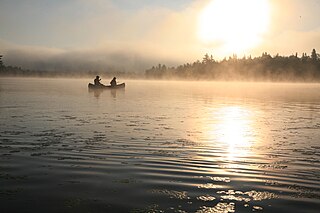
La Mauricie National Park is a national park located near Shawinigan in the Laurentian mountains, in the Mauricie region of Quebec, Canada. It covers 536 km2 (207 sq mi) in the southern Canadian Shield region bordering the Saint Lawrence lowlands. The park contains 150 lakes and many ponds.

Saint-Tite is a Canadian city located at the foothills of the Laurentians, between Grandes-Piles and Saint-Adelphe, in the Mauricie RCM of Mékinac. A large body of water, Lake Pierre-Paul, bathes the northeastern part of the territory.'

Mékinac is a regional county municipality (RCM) of 5,607 km2 located in the administrative region of Mauricie, along the Saint-Maurice River, which also crosses the RCM from one end to the other, and the Matawin River, a tributary of the Saint-Maurice. Located in the province of Quebec, Canada.

The Saint-Maurice River, or the Saint-Maurice River, is one of the main tributaries of the St. Lawrence River, after the Ottawa and the Saguenay Rivers and drains an area of 42,735 km2. It touches the Lake Saint John watershed to the north; the Nottaway River watershed, a major tributary of James Bay, to the northwest; and the southwestern tributaries of the Ottawa River. The Saint-Maurice River is located on the north shore of the St. Lawrence River in Quebec, Canada.

Saint-Séverin is a parish municipality in Quebec (Canada) in the Mékinac Regional County Municipality, Quebec, in the administrative region of Mauricie and watershed the Batiscanie. At various times, the place was also known as Saint-Séverin-de-Proulxville and Proulxville.

Route 155 is a north/south highway on the north shore of the Saint Lawrence River in Quebec, Canada. Its northern terminus is in Chambord at the junction of Route 169, and the southern terminus is the Piles Bridge in Shawinigan. Previously the highway continued to Autoroute 20 but that section was decommissioned in 2006 when Autoroute 55 was completed.

Sainte-Thècle is a Canadian municipality located in the province of Quebec in the Mékinac Regional County Municipality, in the Batiscanie watershed, in the administrative region of Mauricie. This municipality of 216 square kilometres is known for its resorts and many small lakes. The forest and mountain scenery offers exceptional views for tourists and vacationers. Sainte-Thècle is also a destination for hunting, fishing, snowmobile/all-terrain vehicles and other outdoor sports. The church, rectory and cemetery are located on the main hill of the village and are also heritage sites of interest. The municipality's agricultural and forestry industries have marked its history.

Hérouxville is a parish municipality in the Mékinac Regional County Municipality in the administrative region of Mauricie, in the province of Quebec, Canada. Its watershed is mainly part of the Batiscanie.

Saint-Roch-de-Mékinac is a parish municipality in the Mékinac Regional County Municipality, in administrative region of Mauricie, in the province of Quebec in Canada.

Trois-Rives is a municipality with an area of 675 square kilometres (261 sq mi) located in Mékinac Regional County Municipality, in the Mid-Mauricie, province of Quebec, Canada.

Rivière des Envies is located in Canada, in the province of Quebec, in the Mauricie administrative region, in the Batiscanie. Rivière des Envies course 74 kilometres (46 mi) from the outlet of Lac-de-la-Traverse, located in row St-Joseph, Sainte-Thècle. This lake is fed by the outlet of Lake Aylwin, which in turn is fed by the discharge of Lake Jesuit.
The Mékinac Lake is a large lake of freshwater of province of Quebec (Canada), located mainly in the municipality Trois-Rives, in Mekinac Regional County Municipality, in the administrative region of Mauricie, in the province of Quebec, in Canada. The northern part of the lake and the bottom of the Bigué Bay are within the La Tuque.

The North Mekinac River flows from North to South, in three municipalities, in Mauricie region, Mékinac Regional County Municipality, Quebec, Canada.
The Lake Archange is located at the boundary of Sainte-Thècle and Grandes-Piles, in the Mekinac Regional County Municipality, in Mauricie, in Quebec, Canada.
The Lejeune Township is located in the MRC Mekinac Regional County Municipality, in Mauricie, Quebec, Canada.

The lac du Fou is located in the municipality of Saint-Roch-de-Mékinac, in La Mauricie National Park, in the region Mauricie, in Quebec, in Canada. Located west of the Saint-Maurice River, this lake is surrounded by forest and is mainly used for outdoor activities by visitors of La Mauricie National Park.

Lake Roberge is located in the municipality of Grandes-Piles, in the MRC Mekinac Regional County Municipality, in Mauricie, in Quebec, in Canada.
The Roberge Lake is located in the unorganized territory of Lac-Masketsi, Quebec, the Mekinac Regional County Municipality, in Mauricie, in Quebec, in Canada. This lake whose surface is usually frozen from November to April is located entirely in forest land.
The Lac Fontaine is a lake located in the municipality of Grandes-Piles, in the Mékinac Regional County Municipality, in Mauricie, in Quebec, in Canada.




















